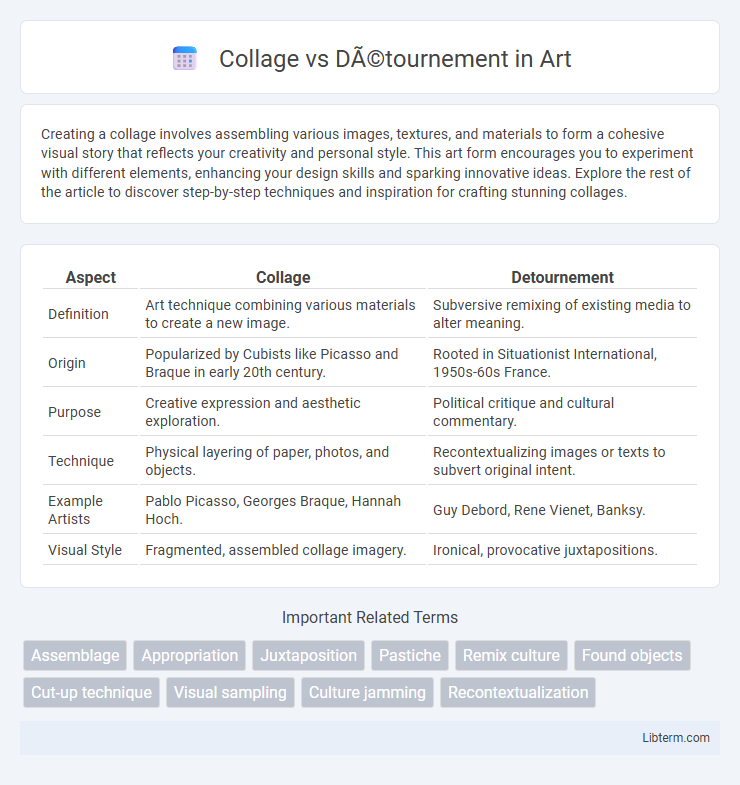Creating a collage involves assembling various images, textures, and materials to form a cohesive visual story that reflects your creativity and personal style. This art form encourages you to experiment with different elements, enhancing your design skills and sparking innovative ideas. Explore the rest of the article to discover step-by-step techniques and inspiration for crafting stunning collages.
Table of Comparison
| Aspect | Collage | Detournement |
|---|---|---|
| Definition | Art technique combining various materials to create a new image. | Subversive remixing of existing media to alter meaning. |
| Origin | Popularized by Cubists like Picasso and Braque in early 20th century. | Rooted in Situationist International, 1950s-60s France. |
| Purpose | Creative expression and aesthetic exploration. | Political critique and cultural commentary. |
| Technique | Physical layering of paper, photos, and objects. | Recontextualizing images or texts to subvert original intent. |
| Example Artists | Pablo Picasso, Georges Braque, Hannah Hoch. | Guy Debord, Rene Vienet, Banksy. |
| Visual Style | Fragmented, assembled collage imagery. | Ironical, provocative juxtapositions. |
Understanding Collage: Origins and Evolution
Collage originated in early 20th-century modern art, particularly within Cubism and Dada, as artists began combining various materials like newspaper clippings and fabric to create new visual compositions. Its evolution spans multiple movements, including Surrealism and Pop Art, where collage techniques conveyed fragmented realities and cultural critiques. Understanding collage involves recognizing its role in disrupting traditional aesthetics by juxtaposing diverse elements to generate novel meanings and challenge viewers' perceptions.
Détournement Defined: History and Key Principles
Detournement, a concept originating in the 1950s from the Situationist International movement, involves the subversion and recontextualization of existing artistic elements to create new, often politically charged meanings. Unlike collage, which assembles disparate images or texts primarily for aesthetic effect, detournement strategically hijacks cultural artifacts to critique and undermine dominant ideologies. Key principles of detournement include appropriation, reversal, and political satire, making it a powerful tool in radical art and activism.
Artistic Techniques: How Collage and Détournement Differ
Collage involves assembling diverse visual elements such as photographs, paper, and fabric to create a new unified artwork emphasizing juxtaposition and texture. Detournement repurposes existing images or texts from popular culture or media to subvert original meanings and convey critical or political messages. While collage prioritizes aesthetic composition, detournement centers on ideological intervention and recontextualization within an artwork.
Cultural Contexts: Societal Influence on Artistic Methods
Collage and Detournement reflect distinct cultural contexts shaping their artistic methods; collage, rooted in early 20th-century modernism, often symbolizes fragmentation and reconstruction within mass media culture. Detournement, originating from the Situationist International movement, emphasizes subverting existing cultural symbols and capitalist messages as a form of political resistance. Societal influence on these methods reveals how collage adapts visual elements for creative expression, while Detournement manipulates them to critique and disrupt dominant ideological narratives.
Purpose and Intent: Subversion vs. Assembly
Detournement aims to subvert and challenge dominant cultural narratives by recontextualizing existing media to create new, often political, meanings that critique societal norms. Collage focuses on the assembly of diverse visual or textual elements to produce novel compositions, emphasizing creative juxtaposition over direct ideological confrontation. While collage prioritizes aesthetic innovation and synthesis, detournement serves as a tool for ideological disruption and critical intervention.
Iconic Works: Notable Examples in Collage and Détournement
Iconic works in collage include Pablo Picasso's "Still Life with Chair Caning" and Hannah Hoch's "Cut with the Kitchen Knife," which combine disparate images to create new meanings through juxtaposition. In detournement, Guy Debord's "Can Dialectics Break Bricks?" and the Situationist International's altered advertisements exemplify the technique of reappropriating existing media to subvert original messages. Both methods utilize cultural artifacts but differ in intent: collage emphasizes artistic synthesis, while detournement focuses on political critique and cultural disruption.
Influence on Modern Art Movements
Collage, pioneered by artists like Pablo Picasso and Georges Braque, revolutionized modern art by integrating diverse materials and images to create layered compositions, directly influencing Cubism and later movements such as Surrealism and Pop Art. Detournement, originating from the Situationist International, subverts existing media and cultural elements to critique mainstream narratives, profoundly shaping Conceptual Art and street art's political engagement. The interplay between collage's constructive assembly and detournement's disruptive recontextualization continues to inspire contemporary art's exploration of meaning and representation.
Legal and Ethical Considerations in Appropriation
Collage and Detournement involve the appropriation of existing images or texts, raising complex legal issues around copyright infringement and fair use, with collage often subjected to stricter scrutiny due to commercial exploitation risks. Ethical considerations emphasize respecting original creators' rights and avoiding cultural misappropriation, while detournement challenges societal norms by subverting meaning, potentially blurring the line between transformation and plagiarism. Both practices require a careful balance between creative expression and adherence to intellectual property laws to avoid legal disputes and preserve artistic integrity.
Digital Age: Collage and Détournement in Contemporary Media
Collage in the Digital Age leverages software tools like Photoshop and Canva to seamlessly combine diverse digital images, creating layered and multifaceted visuals that reflect contemporary culture. Detournement, popularized in digital activism and meme culture, repurposes existing media elements to subvert original meanings and critique societal norms through satire and irony. Both techniques thrive in social media platforms where rapid dissemination amplifies their impact in reshaping public discourse and artistic expression.
Choosing Your Approach: Which Method Suits Your Message?
Choosing between collage and detournement depends on the intended message and desired impact. Collage combines diverse visual elements to create new meanings through juxtaposition, ideal for highlighting contrasts or layering multiple perspectives. Detournement transforms existing images or texts by subverting their original context, making it effective for critical commentary or challenging dominant narratives.
Collage Infographic

 libterm.com
libterm.com